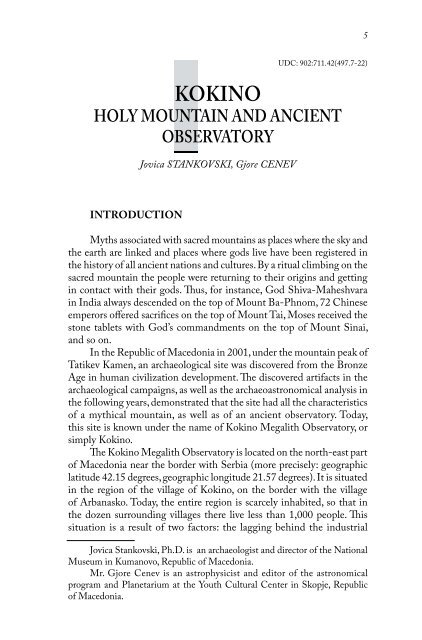CULTURAL HERITAGE: - Macedonian Information Centre
CULTURAL HERITAGE: - Macedonian Information Centre
CULTURAL HERITAGE: - Macedonian Information Centre
Create successful ePaper yourself
Turn your PDF publications into a flip-book with our unique Google optimized e-Paper software.
KOKINO<br />
HOLY MOUNTAIN AND ANCIENT<br />
OBSERVATORY<br />
INTRODUCTION<br />
Jovica StankovSki, Gjore Cenev<br />
Myths associated with sacred mountains as places where the sky and<br />
the earth are linked and places where gods live have been registered in<br />
the history of all ancient nations and cultures. By a ritual climbing on the<br />
sacred mountain the people were returning to their origins and getting<br />
in contact with their gods. Thus, for instance, God Shiva-Maheshvara<br />
in India always descended on the top of Mount Ba-Phnom, 72 Chinese<br />
emperors offered sacrifices on the top of Mount Tai, Moses received the<br />
stone tablets with God’s commandments on the top of Mount Sinai,<br />
and so on.<br />
In the Republic of Macedonia in 2001, under the mountain peak of<br />
Tatikev Kamen, an archaeological site was discovered from the Bronze<br />
Age in human civilization development. The discovered artifacts in the<br />
archaeological campaigns, as well as the archaeoastronomical analysis in<br />
the following years, demonstrated that the site had all the characteristics<br />
of a mythical mountain, as well as of an ancient observatory. Today,<br />
this site is known under the name of Kokino Megalith Observatory, or<br />
simply Kokino.<br />
The Kokino Megalith Observatory is located on the north-east part<br />
of Macedonia near the border with Serbia (more precisely: geographic<br />
latitude 42.15 degrees, geographic longitude 21.57 degrees). It is situated<br />
in the region of the village of Kokino, on the border with the village<br />
of Arbanasko. Today, the entire region is scarcely inhabited, so that in<br />
the dozen surrounding villages there live less than 1,000 people. This<br />
situation is a result of two factors: the lagging behind the industrial<br />
Jovica Stankovski, Ph.D. is an archaeologist and director of the National<br />
Museum in Kumanovo, Republic of Macedonia.<br />
Mr. Gjore Cenev is an astrophysicist and editor of the astronomical<br />
program and Planetarium at the Youth Cultural Center in Skopje, Republic<br />
of Macedonia.<br />
5<br />
UDC: 902:711.42(497.7-22)


